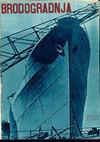规则头波和斜波推进因素的数值研究
IF 4.2
4区 工程技术
Q1 ENGINEERING, MARINE
引用次数: 7
摘要
本文应用雷诺平均Navier-Stokes(RANS)方法研究了在头波和斜波中的推进性能。采用有限体积法(FVM)对控制方程进行离散化,并采用SST k-ω模型对湍流进行建模。自由表面采用流体体积法求解。滑动网格技术用于使螺旋桨旋转。螺旋桨开放水域曲线由螺旋桨开放水域模拟确定。静水阻力和波浪附加阻力是在没有螺旋桨的情况下通过拖曳计算获得的。在不同载荷的静水和波浪中进行了自推进模拟,获得了自推进点,并采用推力识别方法预测了推进因子。考虑波长为船长0.6至1.4倍的规则头波和入射方向为0°至360°的斜波。讨论了波浪对推进因素的影响,包括推力推导和尾流分数、开放水域、相对旋转、船体和推进效率。本文章由计算机程序翻译,如有差异,请以英文原文为准。
NUMERICAL STUDY ON PROPULSIVE FACTORS IN REGULAR HEAD AND OBLIQUE WAVES
This paper applies Reynolds-averaged Navier-Stokes (RANS) method to study propulsion performance in head and oblique waves. Finite volume method (FVM) is employed to discretize the governing equations and SST k-ω model is used for modeling the turbulent flow. The free surface is solved by volume of fluid (VOF) method. Sliding mesh technique is used to enable rotation of propeller. Propeller open water curves are determined by propeller open water simulations. Calm water resistance and wave added resistances are obtained from towing computations without propeller. Self-propulsion simulations in calm water and waves with varying loads are performed to obtain self-propulsion point and thrust identify method is use to predict propulsive factors. Regular head waves with wavelengths varying from 0.6 to 1.4 times the length of ship and oblique waves with incident directions varying from 0° to 360° are considered. The influence of waves on propulsive factors, including thrust deduction and wake fraction, open water, relative rotative, hull and propulsive efficiencies are discussed.
求助全文
通过发布文献求助,成功后即可免费获取论文全文。
去求助
来源期刊

Brodogradnja
ENGINEERING, MARINE-
CiteScore
4.30
自引率
38.90%
发文量
33
审稿时长
>12 weeks
期刊介绍:
The journal is devoted to multidisciplinary researches in the fields of theoretical and experimental naval architecture and oceanology as well as to challenging problems in shipbuilding as well shipping, offshore and related shipbuilding industries worldwide. The aim of the journal is to integrate technical interests in shipbuilding, ocean engineering, sea and ocean shipping, inland navigation and intermodal transportation as well as environmental issues, overall safety, objects for wind, marine and hydrokinetic renewable energy production and sustainable transportation development at seas, oceans and inland waterways in relations to shipbuilding and naval architecture. The journal focuses on hydrodynamics, structures, reliability, materials, construction, design, optimization, production engineering, building and organization of building, project management, repair and maintenance planning, information systems in shipyards, quality assurance as well as outfitting, powering, autonomous marine vehicles, power plants and equipment onboard. Brodogradnja publishes original scientific papers, review papers, preliminary communications and important professional papers relevant in engineering and technology.
 求助内容:
求助内容: 应助结果提醒方式:
应助结果提醒方式:


